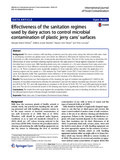| dc.contributor.author | Wafula, Wanjala N | |
| dc.contributor.author | Matofari, Wafula J | |
| dc.contributor.author | Nduko, Masani J | |
| dc.contributor.author | Lamuka, Peter | |
| dc.date.accessioned | 2017-04-06T09:25:32Z | |
| dc.date.available | 2017-04-06T09:25:32Z | |
| dc.date.issued | 2017 | |
| dc.identifier.citation | Wafula et al. International Journal of Food Contamination (2016) 3:9 DOI 10.1186/s40550-016-0032-8 | en_US |
| dc.identifier.uri | https://foodcontaminationjournal.springeropen.com/articles/10.1186/s40550-016-0032-8 | |
| dc.identifier.uri | http://hdl.handle.net/11295/100761 | |
| dc.description.abstract | Background
The most common milk handling containers used by dairy actors along the informal milk value chain in developing countries are plastics jerry cans which are difficult to effectively be cleaned thus contributing immensely to milk contamination and consequently post-harvest losses. The aim of this study was to determine the effectiveness of some common cleaning regimes used by the dairy actors in Kenya against reduction of surface microbial load on jerry cans. Milk handling plastic jerry can containers (n = 16) were obtained from dairy actors and then subjected to four different commonly used cleaning regimes alongside a control experiment of aluminium cans (n = 4). These containers were aseptically swabbed in three replicates before and after the application of a cleaning regime and the swabs (n = 120) analyzed for Total Viable Count (TVC), Total Coliform Count (TCC) and Lactic Acid Bacteria (LAB). The quantitative mean difference of the bacterial load reduction between before and after the application of a cleaning regime was used as the measure of its effectiveness.
Results
The study found out that irrespective of the cleaning, the type of container was significant (P < 0.001) in the reduction of microbial contaminants, whereby the aluminium cans had the highest microbial load reduction of 86, 85 and 96 % for TVC, TCC and LAB respectively as compared to 40, 28 and 42 % for TVC, TCC and LAB respectively for plastic jerry cans. The use of a commercial scourer in the cleaning was found to significantly reduce (P < 0.05) only TVC and TCC.
Conclusions
The results from this study explains the unsuitability of plastic jerry cans in handling of milk and a risk factor for milk post-harvest losses in Kenya through microbial contamination. | en_US |
| dc.language.iso | en | en_US |
| dc.publisher | University of Nairobi | en_US |
| dc.subject | Plastic jerry cans, Contaminatio n, Post-harvest losses, Nakuru | en_US |
| dc.title | Effectiveness of the sanitation regimes used by dairy actors to control microbial contamination of plastic jerry cans' surfaces | en_US |
| dc.type | Article | en_US |

